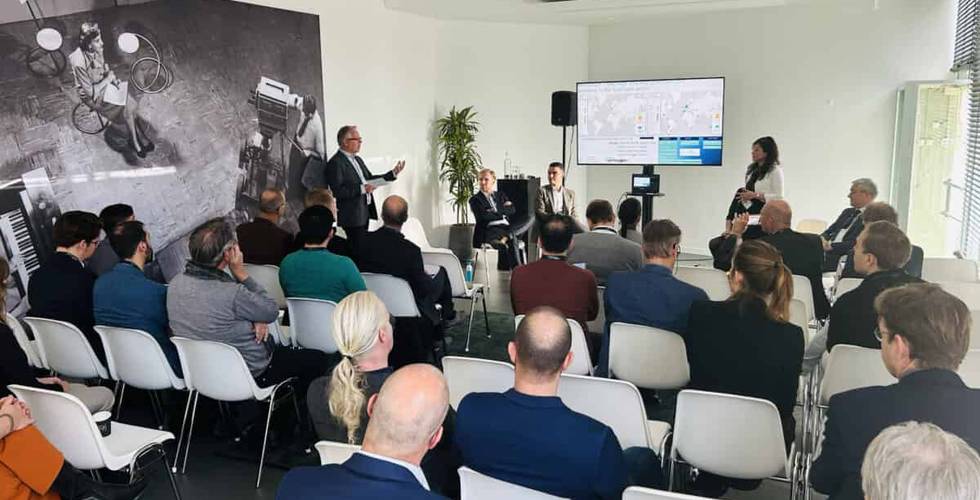In deze 13 projecten werken in totaal 34 partners samen aan technologische innovaties op het gebied van waterstof, waarvan er 24 unieke partners zijn. Hieronder vallen 6 kennisinstellingen (TNO, HAN (Hogeschool Arnhem Nijmegen), Universiteit Twente, TU Delft, VSL, Haagse Hogeschool). Verdere deelname omvat 15 MKB[1] (XINTC BV, HYGRO, HyGear, Magneto, SALDtech, Mateq Process BV, Cryoworld BV, Madern, Liqal, Somni Solutions, Opra, Wintersol, HyET, Nedstack, Battolyser Systems), 2 grote bedrijven ( Krohne, Toyota Motor Europe) en één fieldlab (Green Village).
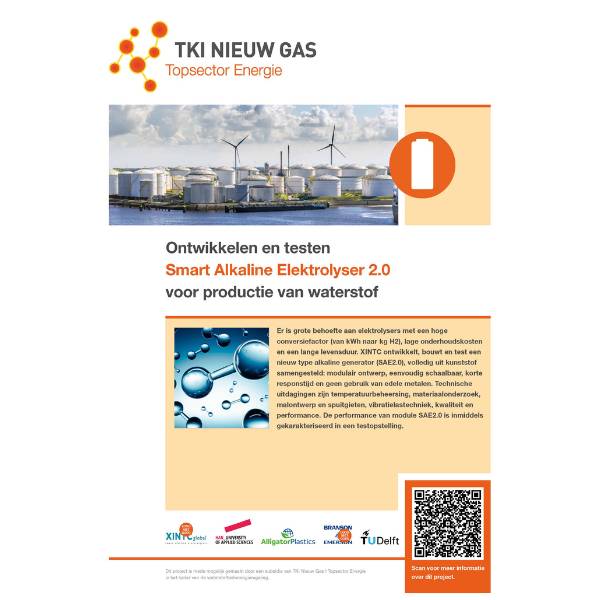
Ontwikkelen en testen SAE 2.0 module en onderzoek opschalingsmogelijkheden [TKI2021-H2-01]
Aanleiding
De mondiale vraag naar waterstof als CO2-vrije energiedrager ontwikkelt zich in hoog tempo. Er is grote behoefte aan elektrolysers met een hoge conversiefactor (kWh naar kg H2), lage onderhoudskosten en een lange levensduur. Aangezien de stroominkoop 70-80% van de kostprijs van waterstof bepaalt, richt dit onderzoek zich op efficiëntieverhoging, standaardisatie van componenten en kostenverlaging door
automatisering van het productieproces. Hierbij kiest XINTC voor een nieuw type alkaline generator dat afwijkt van de conventionele PEM/alkaline systemen. Het beoogde systeem heeft aanzienlijk lagere aanschaf- en onderhoudskosten en is geschikt om optimaal gebruik te maken van een fluctuerend energie-aanbod van PV en/of wind.
De belangrijkste eigenschappen van de te ontwikkelen Smart Alkaline Elektrolyser afgekort SAE 2.0 zijn: modulair ontwerp, eenvoudig schaalbaar, flexibel inzetbaar, korte responstijd en geen edele materialen als platina of goud. Daarnaast is er geen membraan aanwezig, maar een diafragma, is er geen regulier MEA-onderhoud of stack revisie (normaal elke 3-4 jaar), nominale temperatuur en druk en geen afdichtingsproblemen. Hiermee wordt het systeem nagenoeg onderhoudsvrij met een minimale downtime.
Doel van het project
Het ontwikkelen, bouwen en testen van een kunststof, de SAE 2.0 module, voor de productie van waterstof. Het betreft de doorontwikkeling van een eerder ontwikkeld prototype, de V1.0 stack. De SAE 2.0 modules hebben een groter ‘window of operation’ m.b.t. de stroomdichtheid om optimaal ten behoeve van een variabel stroomaanbod te kunnen worden ingezet. Een systeem gebaseerd op de SAE 2.0 modules zal een beoogde capaciteit hebben van 150kW tot 50+MW (modulair systeem). Hiermee richt XINTC zich specifiek op het middensegment van de wereldwijde markt voor elektrolysers.
Technische uitdaging
De SAE 2.0 is, afgezien van de elektrodes, volledig uit kunststof samengesteld. Een goede warmtehuishouding is hierbij cruciaal in verband met de thermische belastbaarheid en vermindering van het risico op plastische deformatie van de gebruikte kunststoffen. Het introduceren van een innovatieve vibratielastechniek voor het samenstellen van de kunststof multimodule en daarbij af te wijken van het gebruik van pakkingen in de V1.0 stack levert de volgende technische uitdagingen op:
- Temperatuurbeheersing. Onderzoek naar de potentiële warmteontwikkeling onder verschillende conversieniveau ’s en beoordeling van de realiseerbare capaciteit van een vloeistof/gas- doorstroming. Temperatuurbeheersing in de module en het afbakenen van de thermische belastinggrens om het risico op plastische deformatie van de multimodule te voorkomen.
- Materiaalonderzoek. Onderzoek naar fysisch-chemische eigenschappen van kunststofvarianten op basis van gestelde specificaties, vanuit de reeds gekozen kunststofgroep, die enerzijds goed verwerkbaar is met spuitgieten en vibratielassen en anderzijds goede eigenschappen bezit voor de beoogde toepassing als dichtheid, warmtecapaciteit, treksterkte, E-Modulus, buigsterkte, slagsterkte, drukvastheid, relatieve diëlectrische constante, warmtegeleidbaarheid, diëlectrische verliesfactor, uitzettingscoëfficiënt en/of hitte-vormbestendigheid.
- Malontwerp en spuitgieten. Ontwerp, fine-tuning en productie van de mallen (matrijzen) voor het spuitgieten van de verschillende module-componenten o.a. de diafragmaplaat, reactieplaat, kontplaat, cover en evt. tules.
- Vibratielastechniek. Productie van ongelaste modulecomponenten en het ontwikkelen van een lasmethodiek op basis van vibratie waardoor er een vol-vlaks, homogene en duurzaam gas- en vloeistofdichte verbinding ontstaat tussen de onderdelen in de multimodule. Tooling techniek voor het plaatsen van de gelaste componenten in de lasopstelling-machine rekening houdend met automatisering, toleranties, harmonische trillingen en vervormingen van de multimodule.
- Kwaliteit en performance. Testen van de (las)verbindingen en de multimodule op kwaliteit en fysisch-chemische eigenschappen. Performance testing van de SAE module gericht op capaciteit, respons, opschakelbaarheid, en thermische belasting tgv warmteontwikkeling en temperatuur- beheersing door middel van vloeistof/gasdoorstroming. Validatie van verkregen resultaten met de simulaties vanuit een eerder ontwikkeld model.
Korte omschrijving van de activiteiten
Gefaseerd project dat zich richt op de volgende activiteiten en taakverdeling
- Fase 1: Theoretische voorbereiding en materiaalonderzoek gericht op 1) Modellering en simulatie ontwerp en 2) Materiaalonderzoek grondstof groep-specificatie.
- Fase 2: Ontwikkeling matrijzen t.b.v. productie modulecomponenten gericht op 1) Fine-tuning en definitief matrijsontwerp, 2) Matrijsproductie en testen en 3) Productie ongelaste modulecomponenten.
- Fase 3: Vibratielassen en tooling t.b.v. productie multimodule gericht op 1) Optimalisatie vibratielasmethodiek, 2) Productie tooling techniek en 3) Productie multimodule.
- Fase 4: Kwaliteitstoetsing en performance testing gericht op 1) Kwaliteitstoetsing gelaste multimodule, 2) Performance testing en validatie warmtehuishouding en 3) Evaluatie, follow-up en afronding.
Resultaat
Module SAE 2.0 is ontwikkeld en de performance is gekarakteriseerd in een testopstelling. Deze dient een verbeterde efficiency te hebben t.o.v. een ongelaste opbouw met pakkingen met het oog op capaciteitsoutput, conversie efficiëntie en gaskwaliteit. De module zal getest worden onder start/stop en bedrijfscondities volgens normaal operationele parameters en voldoet aan de volgende eisen:
1) nominale werking bedraagt 2.5kW/module,
2) piekbelasting bedraagt 150% t.o.v. nominaal gedurende meer dan 1 uur zonder degradatie van performance,
3) technische gasdichtheid garantie. XINTC verwacht dat de module een levensduur heeft van 15 jaar.
Andere resultaten zijn:
4) de massaproductie van de spuitgietonderdelen is gevalideerd,
5) het geautomatiseerd assembleren en vol-vlaks vibratielassen van de elektrodes, diafragma’s en celplaten is geoptimaliseerd en op kwaliteit en performance gevalideerd en
6) de thermische belastbaarheid en levensduur verwachting is middels simulaties (aanvang) en experimentele validatie (einde project)
gevalideerd.
Deelresultaten zijn: de matrijs, modulecomponenten, vibratielastechniek, gelaste kunststof gasmodule, tooling, kwaliteitstoetsing en performance testing
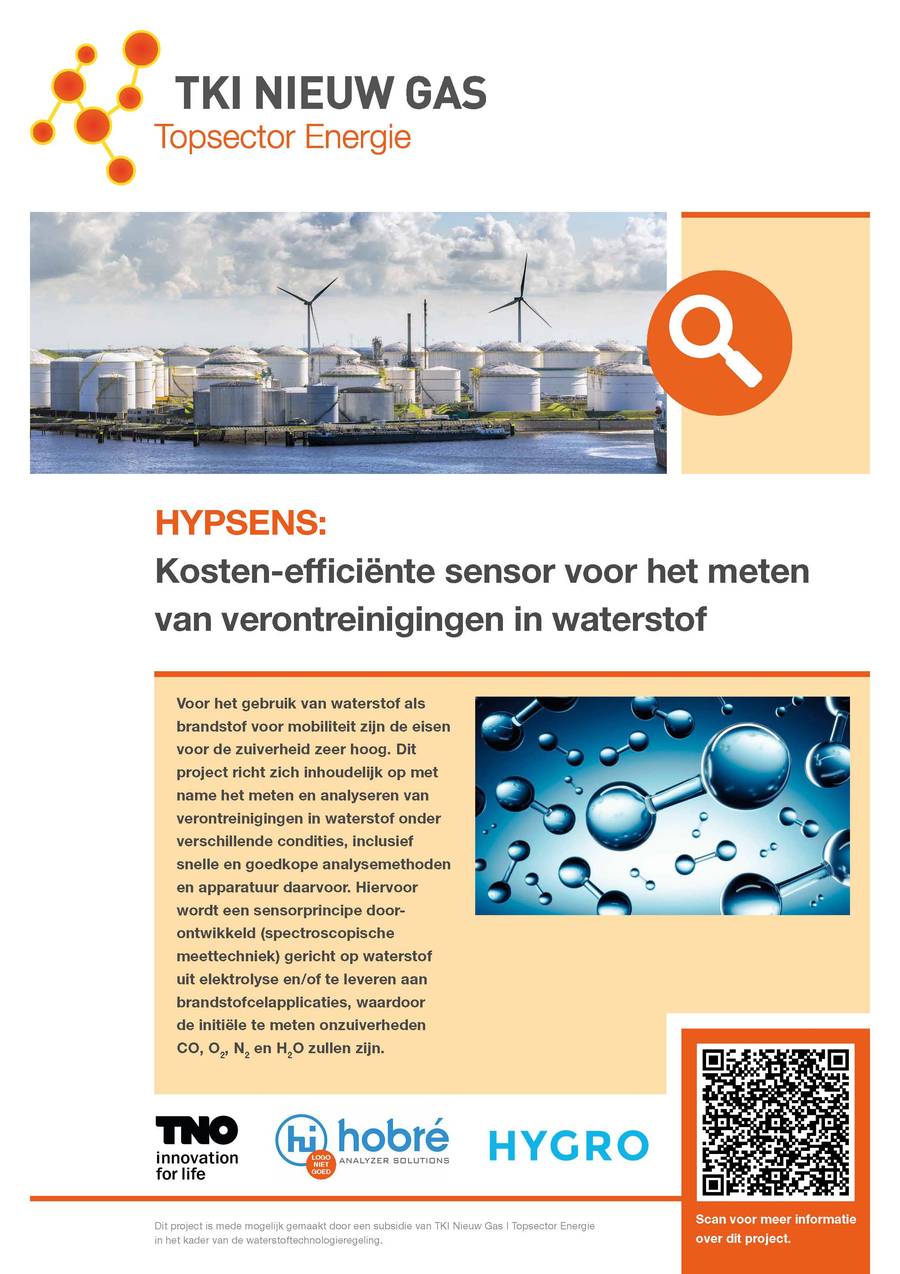
HYdrogen Purity SENSor - HYPSENS [TKI2021-H2-02]
Introduction
Hydrogen fuel cell technology holds great promise for a more sustainable future in the transportation industry. As a clean burning gas, hydrogen does not generate the taxie emissions associated with conventional fossil fuels. Furthermore, hydrogen can be produced from a variety of renewable sources, which makes it a green option for mobility applications.
Hydrogen must maintain an extremely high level of purity during its production, storage, and distribution so it can be effectively used as a fuel. This is the case because even small levels of contamination can damage or destroy fuel cells. As a result, a standard was established (ISO 14687:2019) that specifies the minimum quality characteristics of hydrogen fuel for vehicle and stationary applications. Summarized requirements are shown below.
The way that hydrogen is produced aften determines the most likely contaminants. For example, hydrogen sulfide (H2S) and carbon monoxide (CO) tend to be most problematic for steam methane reforming (SMR) processes, white water (H2O), oxygen (02), and nitrogen (N2) contaminants can be more frequently observed with electrolytic systems. Currently, there are no cost effective and rapid analysis systems that can detect these contaminants. Relatively sophisticated laboratory equipment (such as gas chromatography- mass spectrometry) is available, but these tend to be too expensive (50 - 100k€) and complex for the market.
Objectives
The primary goal of the HYPSENS project is to develop cost-effective technologies to measure and analyze impurities in hydrogen gas streams. In particular, applications such as hydrogen filling stations are tar geted because the storage capacity is low (and therefore, the cost-tolerance is relatively low) as well as local production sites utilizing electrolysis. An effective sensor would allow a producer to monitor the hydrogen quality and intervene immediately if contaminants are present.
Because the ISO standards for purity are extremely high, the associated detection systems must have complimentary performance, white remaining affordable and able to operate continuously. This type of equipment is needed to successfully establish hydrogen infrastructure chains through the lowering of CAPEX/OPEX, which reduces maintenance requirements and improves reliability.
To meet these demands, we investigated analysis techniques suitable for impurity detection and quanti fication, including rapid and inexpensive systems capable of high-pressure operation. Our goal was to achieve a technology readiness level (TRL) of 4, which would demonstrate that the concept was suitable for the target contaminants at relevant concentrations.
Consortium
Netherfands Organization for Appfied Scientific Research (TNO) - Coordinator
TNO's ambition is to work with knowledge institutions, companies and the government to accelerate the energy transition so that the Netherlands hos an energy system without CO₂ emissions by 2050. This also gives the Dutch business community the opportunity to take the lead and export their innovative products and thus contribute globally to the energy transition.
Within the Energy & Materials Transition unit, technology development is underway to accelerate the application of hydrogen. One of the technology areas involves measuring the composition of natura[ gas/hydrogen mixtures and assessing hydrogen purity. TNO hos experts, lab facilities, and an external network to give shape to these developments, and, together with partners, to develop concrete products to enable the energy transition.
Hobré Instruments (Hobré)
Hobré is a manufacturer of analyzers in the energy sector and could potentially manufacture a commer cial device for the hydrogen application. Hobré hos collaborated with TNO previously in the field of Ramon Analyzers as the result of a SBIR project, and it hos the ambition to support industry as it transitions to green and efficient processes. In this project, Hobré provided input on genera[ market requirements, fa cilitated test work, and considered implementation scenarios relevant to gas analysis.
HYGRO
HYGRO develops, designs, and operates projects that range from wind energy production to end user support. A characteristic of the HYGRO approach is effective integration of the different parts of the value chain. An important optimization parameter is establishing the lowest integral cost for the end user. In this project, HYGRO provided input on specific requirements based on a consideration of the entire value chain. HYGRO also identified potential points to incorporate sensor technologies, including where it concerned the control of installations/components, and they contributed to the technology roadmap.
Results
In this project, we investigated cost-effective technologies to measure and analyze impurities in hydrogen gas streams. The primary objectives involved selecting meaningful requirements, investigate the feasibility of optica[ systems, testing coatings that produced the desired sensor response characteristics, and identifying promising approaches for future development. The main results are given below.
A memo with the most critica[ requirements and use conditions for sensors including an overview of the optica[ hardware hos been made, in close cooperation of HYGRO, Hobré, and TNO. As most interesting use case was chosen for measuring direct after the electrolyzer. Measuring the impurities in the hydrogen stream just after the electrolyzer allows a producer to benchmark its efficiency and track the ageing and degradation of the electrolyzer stocks. It will also facilitate quality monitoring of the hydrogen fuel after maintenance operations that involve purging the equipment with nitrogen. Another element to monitor is residual water vapor, which hastens corrosion and harms downstream equipment such as compressors. These adverse processes shortens equipment lifetime and increases maintenance casts. The main requirements for an hydrogen purity analyzer at the chosen use case:
- Main contaminants: water, oxygen and nitrogen. Nice to have: Carbon monoxide.
- Pressure up to 40 bar
- Hydrogen Flow up to 50 kg/h
- Pipe diameter 4 inch
- ATEX zone 2
Using literature reports and TNO's past experience, we identified promising materials that could preconcentrate contaminants into a thin coating. In genera[, coatings were made from inorganic compounds as they tend to have fewer absorbances in the mid-infrared compared with organic compounds and have better mechanica[ stability. At the end, we had selected compounds from a diverse range of materials including metal oxides, metal-organic frameworks, metallic complexes, zeolites, and other microporous/mesoporous materials.
Coatings were then successfully tested in the presence of nitrogen, oxygen, carbon monoxide, and water vapor and their performance was characterized with infrared spectroscopy. Carbon monoxide and water both produced significant responses using a variety of materials. Parameters such as sensitivity, response, and recovery times were identified for the most promising coatings, and various preconditioning methods were explored to minimize drift.
Preliminary tests conducted by Hobré using enhanced optical strategies showed significant improvements for oxygen and water vapor detection with Ramon spectroscopy. Coatings developed for infrared analysis could also be incorporated into these devices to further improve sensitivity. Based on the screening results, a Ramon system using either modified opties or coatings would be most suitable for future commercial implementation.
We pursued two approaches in parallel to construct a portable system utilizing infrared spectroscopy. In the first, we conducted a market survey to determine if there were commercial spectrometers and gas cells that could be directly combined into a compact demonstrator. In the second approach, we evaluated designs fora custom optical system. At the conclusion of these assessments, we determined that the combination of a commercial spectrometer and gas cell was the most suitable option for the HYPSENS project. The components identified for the custom optica[ system were relatively low-cost, and these types of parts would be suitable for use in a future, commercial device. Contaminants were tested at high pressure (up to 40 bar), and it was shown that detection was possible at levels relevant to ISO 14687:2019.
Hobré evaluated several coatings using Ramon spectroscopy based on the literature survey and the infrared screening results ofTNO. Materials were first tested by illuminating each sample with the Ramon laser and looking for signs of fluorescence. Coatings that showed minimal levels of fluorescence were exposed to contaminant gases in hydrogen and the response was recorded. These results were then compared with the coating performance in infrared systems.
HYGRO provided an outline for typical field test conditions, and an outlook for future infrared system development was constructed based on this input. The final report contoins information that summarizes the HYPSENS project results.
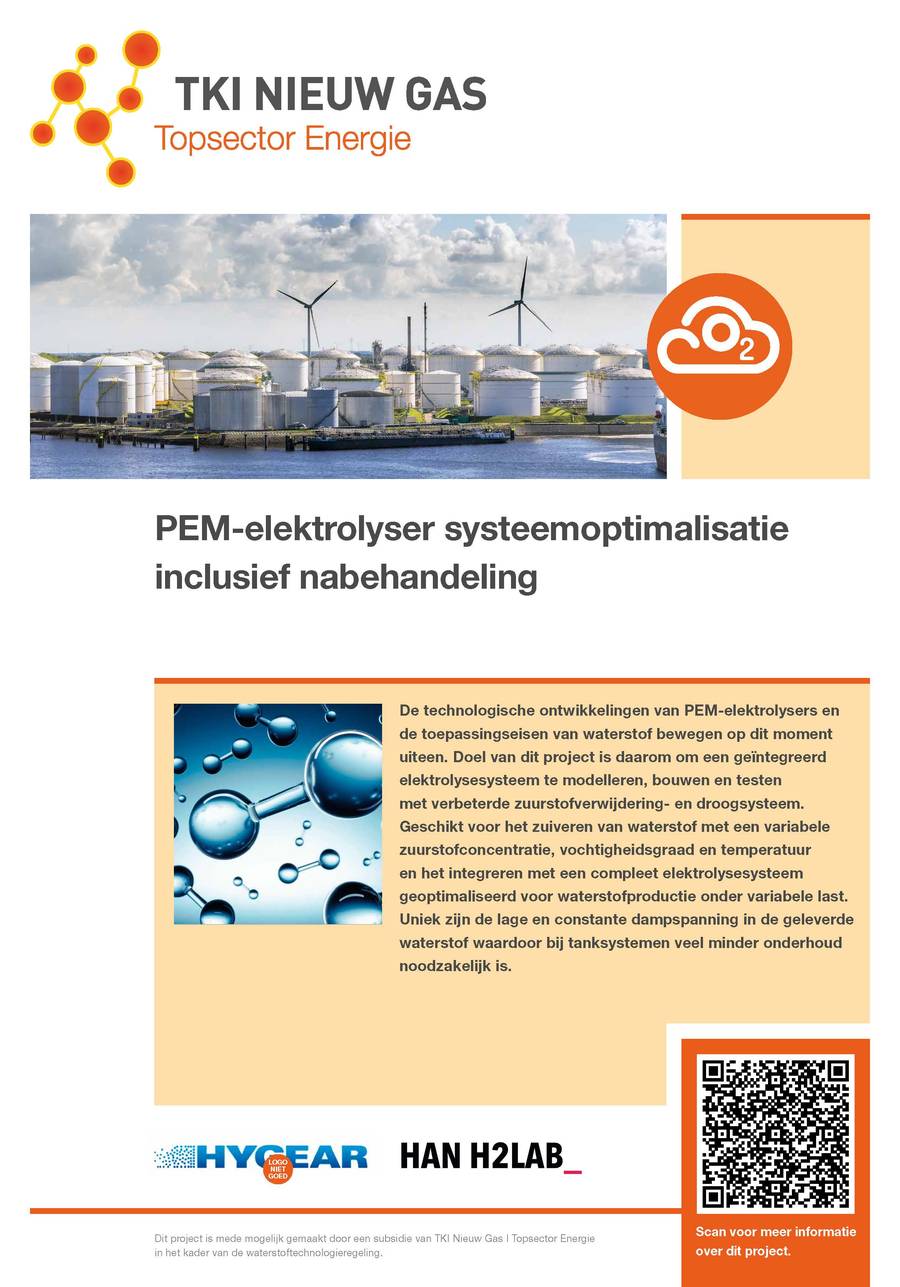
PEM Elektrolyser [TKI2021-H2-07]
Aanleiding
Op dit moment bewegen de technologische ontwikkelingen van PEM-elektrolysers en de
toepassingseisen van waterstof uiteen. Enerzijds beweegt de productieketen van PEM-
elektrolysers richting het gebruik van steeds dunnere membranen, met als voordeel lagere kosten en een hoger rendement. Het nadeel is een hogere oversteek van zuurstof en water, waarvan de concentraties in het geproduceerde waterstof sterk zal fluctueren bij variërend toegeleverd vermogen, wat het geval is bij directe koppeling aan hernieuwbare bronnen. Dit vereist een flexibelere nabehandeling van het waterstof. Anderzijds blijkt aan de toepassingszijde in de praktijk dat de veelgebruikte tankprotocollen niet compatibel zijn met de gaskwaliteitseisen. Deze protocollen blijken in de praktijk een veel lager dauwpunt (tot 0,3 ppmv) in het waterstof te vereisen dan de ISO-norm van 5 ppmv. Bij deze laatste concentratie bevriest de waterdamp al bij -11°C. Dit levert problemen door ijsvorming in de tankapparatuur. resulterend in apparatuur falen en extra onderhoud. HyGear verwacht dat gebruikers in de automotive waterstofmarkt steeds hogere eisen aan het waterstofgas gaan stellen om de
operationele problemen te reduceren.
Doel van het project
Modelleren, bouwen en testen van een geïntegreerd PEM elektrolysesysteem met verbeterde zuurstofverwijdering en droging dat de gevolgen van variabele deellast goed kan volgen in combinatie met een geoptimaliseerd regelsysteem. De technische doelen zijn:
- Ontwikkelen en valideren van stack en systeemmodel specifiek gericht op dynamisch
gedrag en gasoversteek;
- Ontwikkelen van een closed-loop, pressure assisted temperature swing adsorption
droger module met een waterstofopbrengst hoger dan 95%;
- Ontwikkelen van een adaptief regelsysteem dat fluctuerend vermogen koppelt aan de
parameters voor het droogsysteem.
Korte beschrijving van de activiteiten
Het zal uit 6 werkpakketten bestaan met een totale doorlooptijd van 24 maanden:
1. Ontwikkeling en validatie van stack- en systeemmodel (HAN)
2. Katalysator- en sorbentselectie (HyGear/HAN)
3. Ontwikkeling closed-loop, pressure assisted temperature swing adsorption droger
module (HyGear)
4. Systeemmodel en process flow optimalisatie (HAN/HyGear)
5. Samenbouw van droogsysteem (HyGear)
6. Validatie van systeem en control logic (HyGear/HAN)
Een 320 We PEM systeem is in aanbouw op de HAN en een 70 kWe PEM stack unit met power elektronica is aanwezig bij HyGear. Beide zullen gebruikt worden voor de validatie van het stack-model en in dit project uitgebreid worden met deoxo-dryer systeem.
Resultaat
Het project zal een zuurstofverwijdering- en droogsysteem ontwikkelen geschikt voor het zuiveren van waterstof met een variabele zuurstofconcentratie, vochtigheidsgraad en
temperatuur en integreren met een compleet elektrolyser systeem geoptimaliseerd voor
waterstofproductie onder variabele last.
Uniek zal de lage en constante dampspanning in het geleverde waterstof zijn waardoor bij tanksystemen veel minder onderhoud aan het tanksysteem noodzakelijk zal zijn. HyGear zal de systemen verkopen of deze in een Gas-as-a-Service contract bij eindklanten plaatsen. Middels de waterstofkennis en -technologie ontwikkeling met studenten zal dit project ook bijdragen aan de Human Capital Agenda voor de energietransitie.
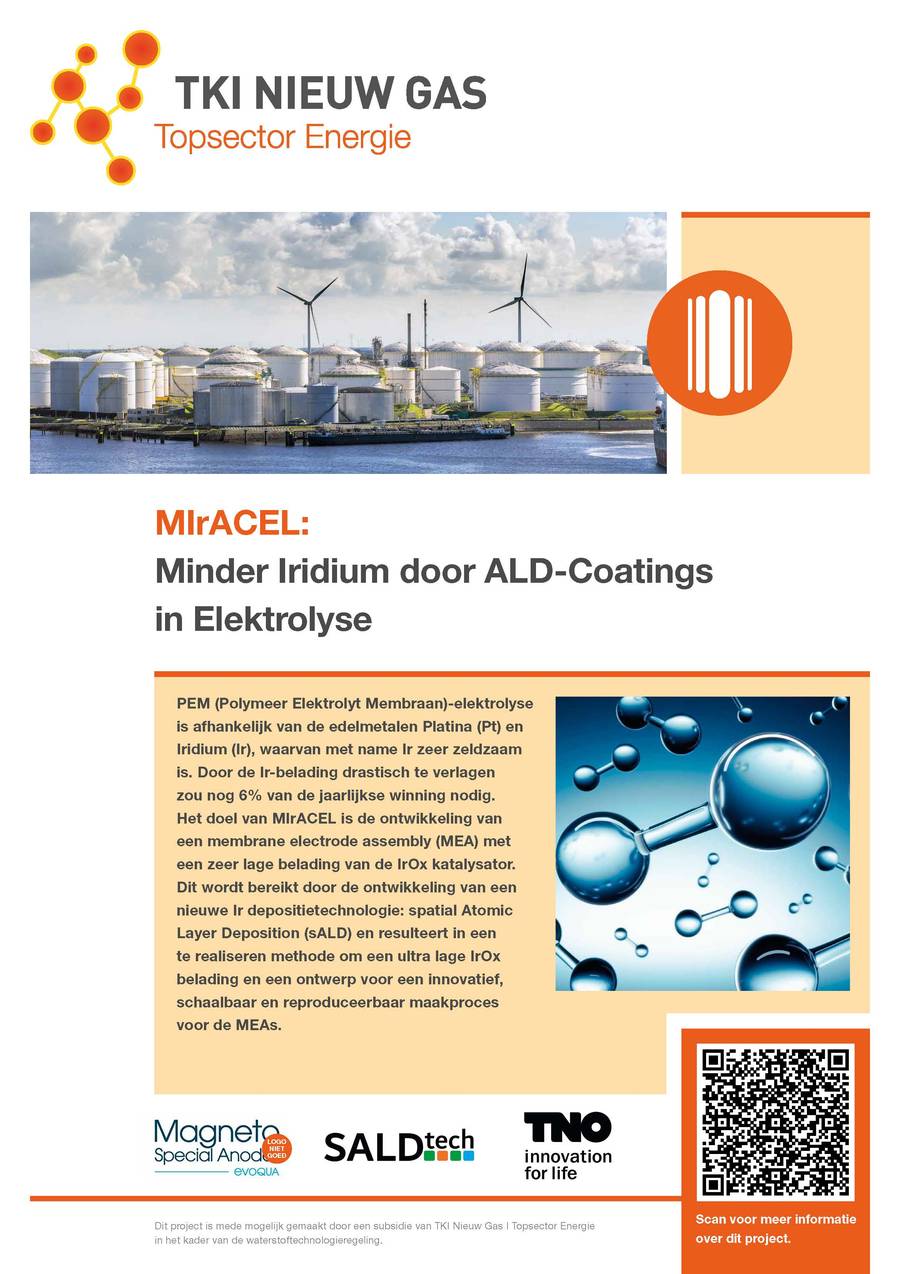
MIraCEL [TKI2021-H2-08]
Aanleiding
Polymeer Elektrolyt Membraan (PEM) – elektrolyse is een van de 2 commerciële groene waterstof technologieën. PEM-elektrolyse is zeer geschikt voor de productie van waterstof uit variabele stroom (m.a.w., groene stroom), zeker op plaatsen waar de ruimte beperkt is, bijvoorbeeld bij offshore windparken. Echter, PEM elektrolyse is afhankelijk van de edelmetalen Platina (Pt) en Iridium (Ir), waarvan met name Ir zeer zeldzaam is. Ir wordt gebruikt als elektrokatalysator voor de zuurstofevolutie reactie aan de anode. Bij de huidige stand-der-techniek, zou 122% van de jaarlijkse Ir winning nodig zijn om te voorzien in de toekomstige Europese vraag naar waterstof. Door de Ir belading drastisch te verlagen kan dit verlaagd worden naar 6%, volgens een recente TNO studie. Dit vraagt echter om een revolutionaire innovatie. In een voorgaand project (INCOME) is een principeproef gedaan met een nieuwe Ir depositietechnologie. MIrACEL zal deze depositietechnologie verder onderzoeken en ontwikkelen.
Doel van het project
Het doel van MIrACEL is de ontwikkeling van een titaan (Ti) Porous Transport Layer (PTL) met een ultradunne, elektrokatalytische Ir coating. Deze gekatalyseerde PTL is een alternatief voor de huidige industriële referentie, een catalyst-coated membrane (CCM) met een standaard PTL. De gekatalyseerde PTL heeft een aanmerkelijk lagere Iridium (Ir) belading (10x lager) dan de industriële referentie, bij vergelijkbare prestaties. Dit wordt bereikt door de ontwikkeling van een nieuwe Ir depositietechnologie, spatial Atomic Layer Deposition (sALD). De sALD-technologie maakt het tevens mogelijk om de productie op te schalen, zowel qua productgrootte als productievolume, en
reproduceerbare en homogene producten te maken. Dit project draagt bij aan de doelstellingen van de call om technologie te ontwikkelen die gebruikmaakt van kleinere hoeveelheden schaarse metalen (Ir) én zorgt voor de vereiste nauwkeurigheid en reproduceerbaarheid op productieschaal.
Resultaat
De resultaten van het MIrACEL project zijn 1) een gekatalyseerde PTL met ultradunne IrOx belading en 2) een ontwerp voor een innovatief, schaalbaar en reproduceerbaar maakproces voor deze gekatalyseerde PTLs. Deze resultaten dragen bij het aan het doel om de kosten van elektrolyse omlaag te brengen richting het doel van 2 $/kg H2, door een PEM-stack te ontwerpen met ≤ 0.2 mg/cm2 (zoals gesteld door International Renewable Energy Agency (IRENA) in 2020) en
geautomatiseerde productieprocessen te gebruiken.
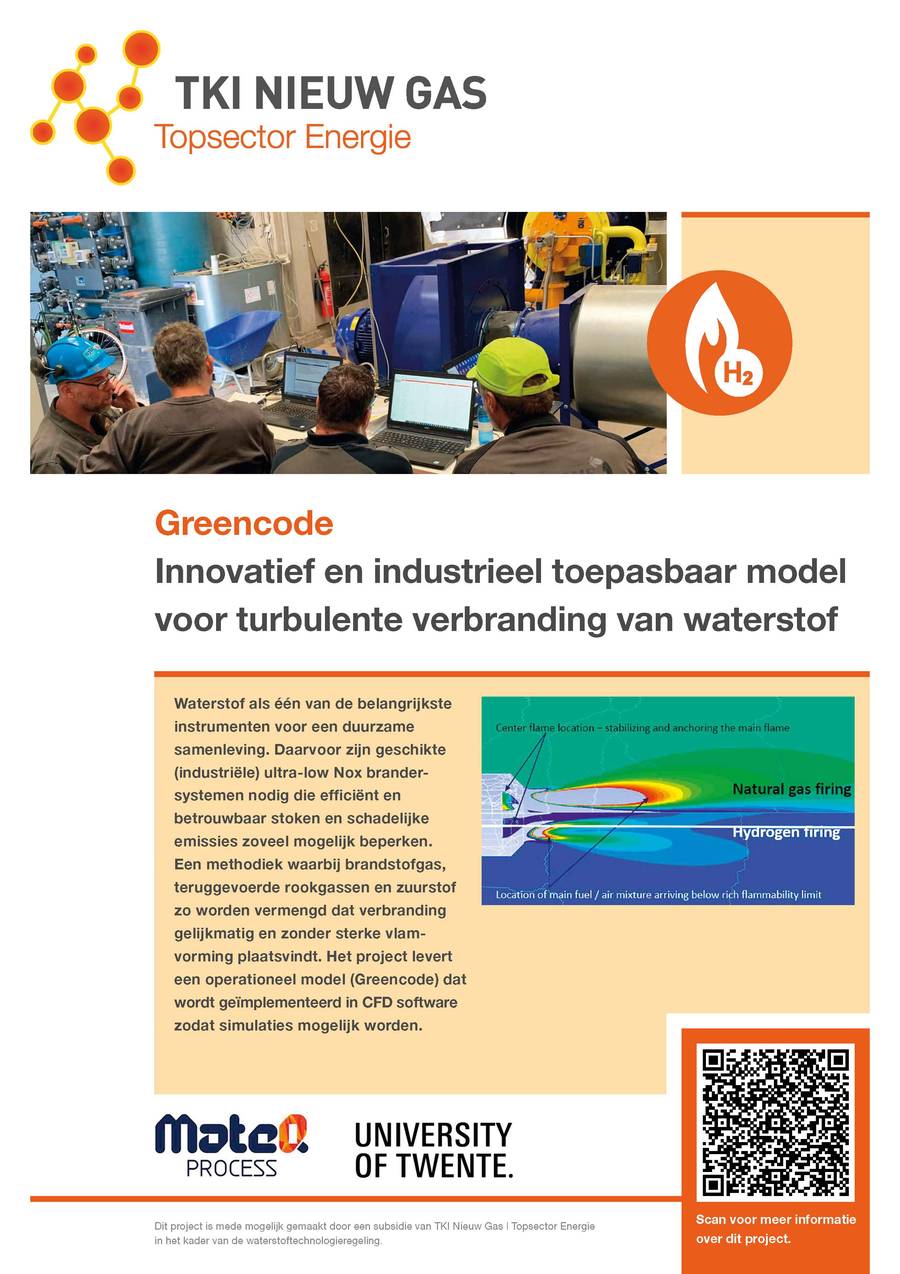
Greencode [TKI2021-H2-09 Greencode]
Aanleiding
Waterstof wordt alom gezien als één van de belangrijkste instrumenten voor een duurzame samenleving. Daartoe zijn o.m. geschikte (industriële) brandersystemen nodig. De nadruk ligt op zowel het efficiënt en betrouwbaar stoken van waterstof als zoveel mogelijk beperken van schadelijke emissies (CO, NOx, CxHy). Stoken van waterstof zonder innovatieve tegenmaatregelen zal tot hoge emissies leiden. Vlamloze thermische oxidatie (MILD-combustion genoemd) wordt als relevante techniek gezien als het doel is ultra-lage NOx verbranding van hoogcalorische brandstoffen zoals waterstof te realiseren. Het is een methodiek waarbij brandstofgas, teruggevoerde rookgassen en zuurstof zo worden vermengd dat verbranding gelijkmatig en zonder sterke vlamvorming plaatsvindt, zodat emissiewaarden significant lager zijn bij gelijkblijvende efficiëntie. Vlamloze thermische oxidatie kan worden bereikt middels een hoge mate van rookgasrecirculatie en scheiding van kucht- en brandstofstromen.
Om wijdverbreide toepassing van MILD-combustion mogelijk te maken, is nauwkeurige modellering van de (chemische) reactiestructuren en hun invloed op performance (gedrag, prestaties, emissies e.d.) nodig.. Huidige commercieel beschikbare en industrieel toepasbare turbulente verbrandingsmodellen zijn primair ontwikkeld voor gasturbines. Zij houden niet - of slechts zeer beperkt - rekening met bijvoorbeeld de grote differentiële diffusie van waterstof, wat veel lastiger te modelleren is dan de gebruikelijke aanname van constante diffusie, die bij koolwaterstofverbranding (zoals aardgas) wel opgaat. Tevens zijn bestaande modellen gebaseerd op de aanname van een duidelijk gedefinieerd vlamfront, zijn ze minder of niet geschikt voor het modelleren van het brandstofrijke deel van een vlam en is er geen – of slechts beperkte – mogelijkheid tot het mee modelleren van externe rookgasrecirculatie. Bij verbrandingsmodellen waar dit wel het geval is, is de benodigde rekenkracht zeer groot, zijn de modellen gevoelig voor gebruiker-instellingen en is een hoge mate van expertise nodig bij het gebruik.
Doelstelling
Doel van het project is ontwikkeling van een betrouwbare en nauwkeurige code die de turbulente verbranding van waterstof/aardgas-mengsels in sterk verdunde vlammen in combinatie met externe rookgasrecirculatie zal beschrijven. De chemische reactiekinetiek daartoe worden vereenvoudigd middels de toepassing van de techniek Computational Singular Perturbation (CSP[1]) die op een nieuwe en inventieve manier toegepast en waardoor de benodigde rekenkracht en geheugenbehoefte beperkt blijft. Het project zal een model opleveren dat vervolgens wordt geïmplementeerd in CFD software zodat simulaties mogelijk worden. Pakketen die daartoe zullen worden gebruikt zijn ANSYS CFD en OpenFOAM.
De te ontwikkelen code zal van automatische en bewezen algoritmen gebruik maken, waardoor het vrij eenvoudig in gebruik zal zijn, beperkte hoeveelheid rekenkracht vereisten en een benodigde expertise van de gebruiker niet overmatig hoeft te zijn. Er wordt aldus een code ontwikkeld die breed en tevens commercieel inzetbaar zal worden (namelijk met behulp van bijvoorbeeld ANSYS Fluent of OpenFoam) en die een marktwaarde zal hebben die benut kan worden door de code in licentie te verkopen aan bedrijven die zich bezig houden met ontwikkeling van verbrandingstechnologie voor waterstof.
Met behulp van het beoogde verbrandingsmodel kan bijvoorbeeld een industrieel branderontwerp van een (nieuwe of omgebouwd) warmwater- en stoomketel worden doorgerekend en kan vooraf een betrouwbare en nauwkeurige voorspelling worden gegeven van gedrag, prestaties en emissies die de brander in de installatie zal leveren. In toenemende mate worden investeringsbeslissingen door exploitanten mede genomen op basis van dit soort berekeningen zodat aldus een voorsprong op de concurrentie kan worden genomen. Het resultaat is derhalve dat met behulp van de programmeerbare code vervolgens CFD simulaties mogelijk worden waarmee inzicht wordt verkregen in te hanteren reken- en ontwerpregels van een waterstofbrander, en een validatie kan geven van de toepassing ervan in een specifieke installatie van een eindgebruiker.
Korte omschrijving van activiteiten
Mateq Process richt zich in dit project primair op het uitwerken van de principiële differentiaalvergelijkingen voor de verbranding van waterstof en mengsels van waterstof met aardgas (mengsels met andere brandstoffen zijn zeer wel mogelijk). Daarnaast richt men zich op het tot stand brengen van de koppeling van de verbrandingscode met bestaande CFD-software alsmede op het uitwerken en demonstreren van de toepassingsmogelijkheden van het verbrandingsmodel bij het ontwerpen van industriële waterstofbranders. De uit te voeren werkzaamheden focussen zich op het implementeren - en daarna aan de hand van gebruikservaringen - optimaliseren van de verbrandingscode in een tweetal CFD-pakketten (zowel commercieel als open source) alsmede het benchmarken van de ontwikkelde code teneinde aan de hand daarvan de toegevoegde waarde ten opzichte van beschikbare (laminaire) verbrandingsmodellen te kwantificeren. Tevens zal zij tezamen met een externe partij de waarde van de code demonsteren door enkele branderontwerpen aan de hand van GREENCODE door te laten rekenen.
Vanuit haar expertise zal de Universiteit Twente zich in het project vooral richten op het softwarematig inrichten en modelleren van de verbrandingscode. Hiertoe zal met name een Postdoc zich vooral focussen op het uitwerken van de chemische reactiekinetiek van waterstofverbranding en het opstellen van transportvergelijkingen voor turbulente verbranding, waarna de uitkomsten in een hanteerbare code worden omgezet. Tevens zal zij de ontwikkelde code aan beschikbare wetenschappelijke data toetsen, zodat aan de hand daarvan validatie van het verbrandingsmodel kan worden gerealiseerd. De dagelijkse begeleiding van de Postdoc zal geschieden door Dr.ir. Jim Kok van de UT alsmede Marco Derksen van Mateq Process.
Resultaat
Het project levert een operationeel model voor het modelleren van de turbulente verbranding van waterstof/aardgas-mengsels in sterk verdunde industriële vlammen. Het verwachte resultaat is samen te vatten als een verbrandingscode - geschikt voor nauwkeurige voorspelling van verbrandingsgedrag en emissies van industriële ultra-low NOx waterstofbranders - en werkend middels automatische, gebruikersvriendelijke algoritmes alsmede inzetbaar met beperkte benodigde rekenkracht.
De beoogde deliverable is dat het verbrandingsmodel is beschikbare CFD software (zowel commercieel beschikbaar als open source) is geïmplementeerd (TRL4), gevalideerd (TRL5) en succesvol is gedemonstreerd in zowel een testomgeving (TRL6) als een operationele omgeving (TRL7). De belangrijkste sub-deliverables van het project zijn als volgt samen te vatten:
- Bruikbare chemische reactiemechanismen voor betrouwbare voorspelling van verbranding van waterstof en waterstof-aardgas mengsels in ultra-low NOx brandertoepassingen.
- Turbulent verbrandingsmodel gebaseerd op CSP-gereduceerde (gedetailleerde) mechanismen.
- Implementatie van verbrandingsmodel in beschikbare CFD software (ANSYS CFX en OpenFoam).
- Validatie van de modelbenadering aan de hand van in (wetenschappelijke) literatuur beschikbare benchmarks.
- Demonstratie van de tool aan de hand van één of meerdere ontwerpen voor een industriële ultra-low NOx waterstofbrander (in samenspraak met een externe partij).
Het project richt zich vooral op ontwikkeling van toepasbare chemische reactiemechanismen, ontwikkeling van een CSP-gebaseerd verbrandingsmodel, implementatie in CFD software alsmede demonstratie in industriële (ultra-lage NOx) ontwerpen. De resultaten sluiten aan bij de Tender Waterstoftechnologie, met name als het gaat om het thema ‘brandertechnologie voor waterstof’ waar de focus ligt op de ontwikkeling van waterstofbranders in combinatie met het voorkomen van NOx emissies.
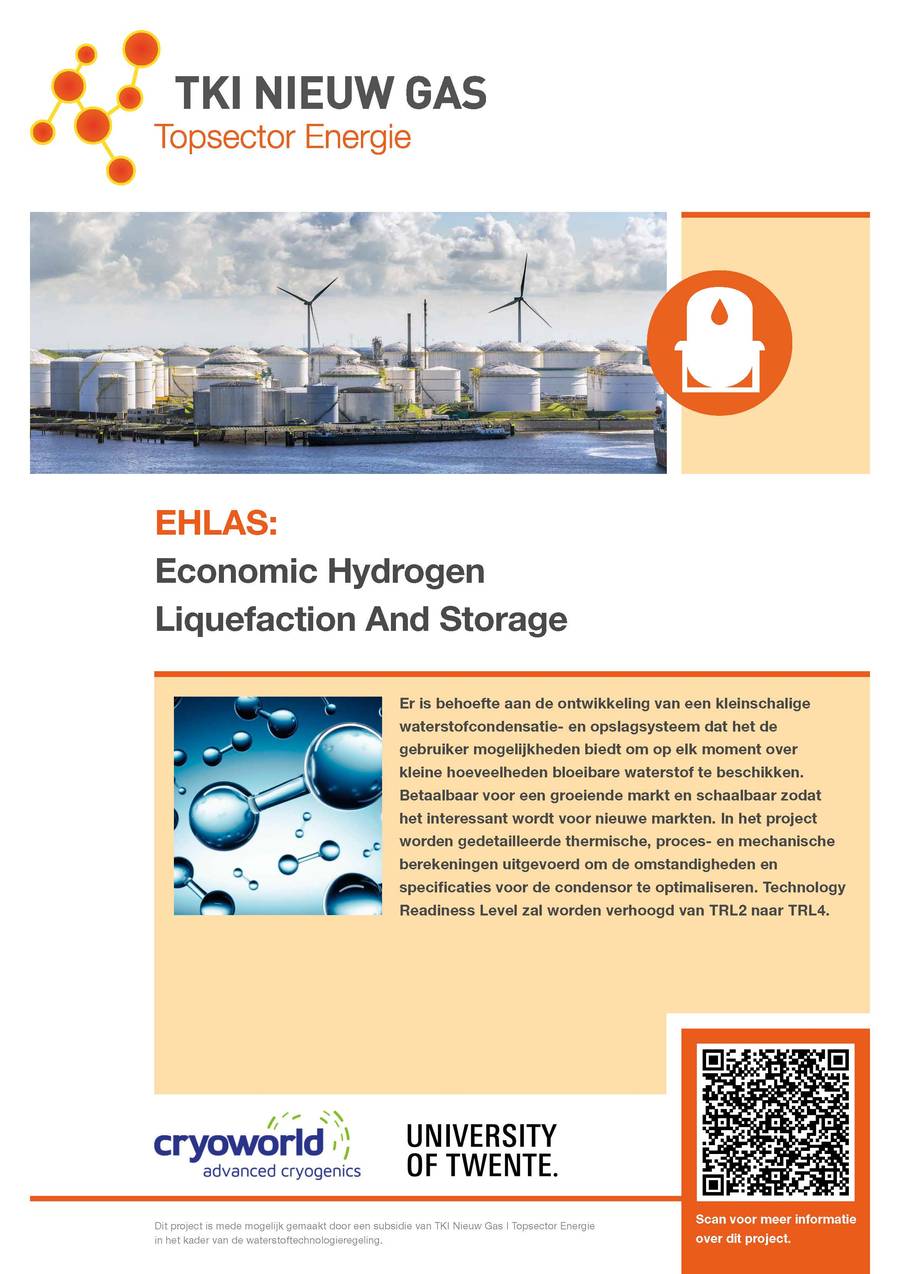
Economic Hydrogen Liquefier And Storage (EHLAS) [TKI2021-H2-10 EHLAS]
Aanleiding
There is a need to develop an affordable small scale hydrogen liquefier that offers the user opportunities to have small amounts of liquid hydrogen available at any time. The liquefier should be cheaper than the ones that are currently available in the market.
Doel van het project
New concept and proof of concept for an economic hydrogen liquefier, making it affordable for a growing market. The concept should be scalable to larger capacities, making it interesting for new markets.
Korte omschrijving van de activiteiten
The main activities in this project focus on the development of a new concept for a hydrogen liquefier system. Detailed thermal, process and mechanical calculations will be performed to optimize circumstances and specifications for the liquefier, providing top efficiency of the process. During the project the Technology Readiness Level will be increased from TRL2 to TRL4. A small demonstrator model with dummy loads will be tested in a laboratory environment for proof of concept.
Resultaat
Result of the project will be validation of the technology for an affordable, scalable hydrogen liquefier
and storage system.
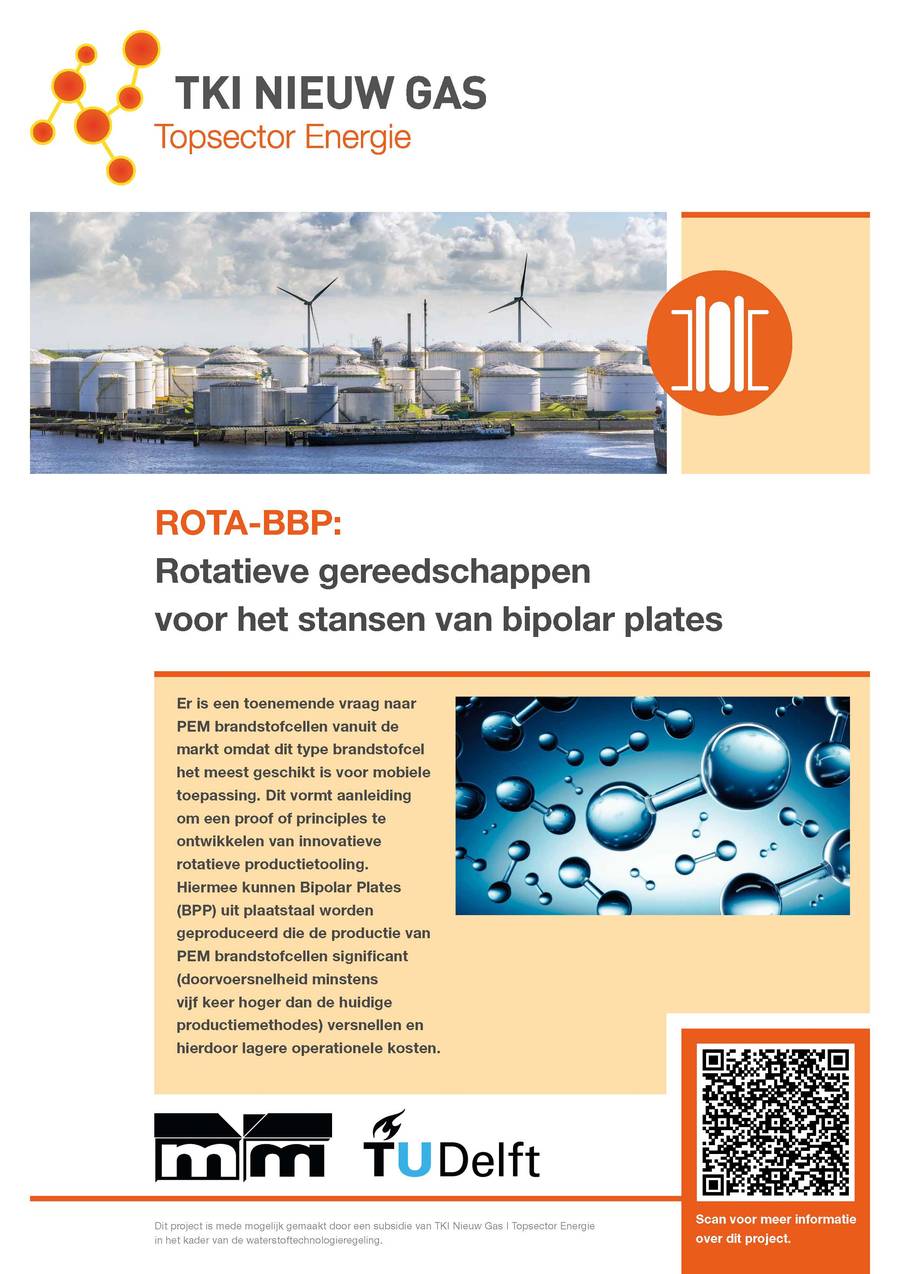
ROTA-BPP [TKI2021-H2-11]
Aanleiding
Huidige methodes voor grootschalige PEM brandstofcelproductie zijn snelheid-gelimiteerd door het discrete karakter van productie van de sub-componenten. Er is een toenemende vraag naar PEM brandstofcellen vanuit de markt omdat dit type brandstofcel het meest geschikt is voor mobiele toepassingen. Dit vormt aanleiding voor Madern om samen met de TU Delft een proof of principle te ontwikkelen van innovatieve rotatieve productietooling die de productie van PEM brandstofcellen significant versnelt.
Doel van het project
Doel van het project is onderzoek te verrichten naar engineering tools om de rotatieve stans- geometrie te kunnen bepalen aan de hand van BPP product specificaties. Dit moet leiden tot een proof of principle van innovatieve rotatieve tooling waarmee Bipolar Plates (BPP) uit plaatstaal kan worden geproduceerd. Hiermee wordt een doorvoersnelheid behaald die minstens vijf keer hoger is dan de huidige productiemethodes, en (hierdoor) lagere operationele kosten met zich mee brengt.
Korte omschrijving van de activiteiten
De TU Delft wil een praktisch toepasbaar simulatiemodel ontwikkelen voor het voorspellen van het gedrag en eigenschappen van zeer dun plaatmateriaal wanneer deze rotatief wordt vervormd. Madern gaat dit model gebruiken om matrijs geometrie te ontwerpen. Het model moet Madern in staat stellen om op basis van het BPP-ontwerp een stansgeometrie te bepalen, en het model wordt gevalideerd op
basis van eindige-elementenmethode (FEA) en Madern's vervormingsexperimenten. De opgedane theoretische kennis zal de basis vormen voor een iteratief ontwerpproces van rotatieve tooling, om optimale geometrieën te bepalen voor het rotatief stansen van plaatstaal. Hiermee zal een demonstratie worden gedaan om te valideren dat de beoogde snelheden kunnen worden behaald.
Resultaat
De doelstellingen en verwachte resultaten van het project zijn:
1. Het opdoen van fundamentele kennis met betrekking tot de plastische vervorming van dun plaatmateriaal in een rotatieve stans.
2. Het modelmatig voorspellen van optimale stans geometrie voor het rotatief stansen van een bipolar plate.
3. Het onderzoeken van verschillende ontwerpen van de rotatieve tooling middels een iteratief proces, om in combinatie met de opgedane theoretische kennis de optimale geometrieën te bepalen
4. Het opleveren van een proof of principle waarmee snelheden behaald kunnen worden die minstens een factor 5 hoger zijn dan de huidige productiemethodes.
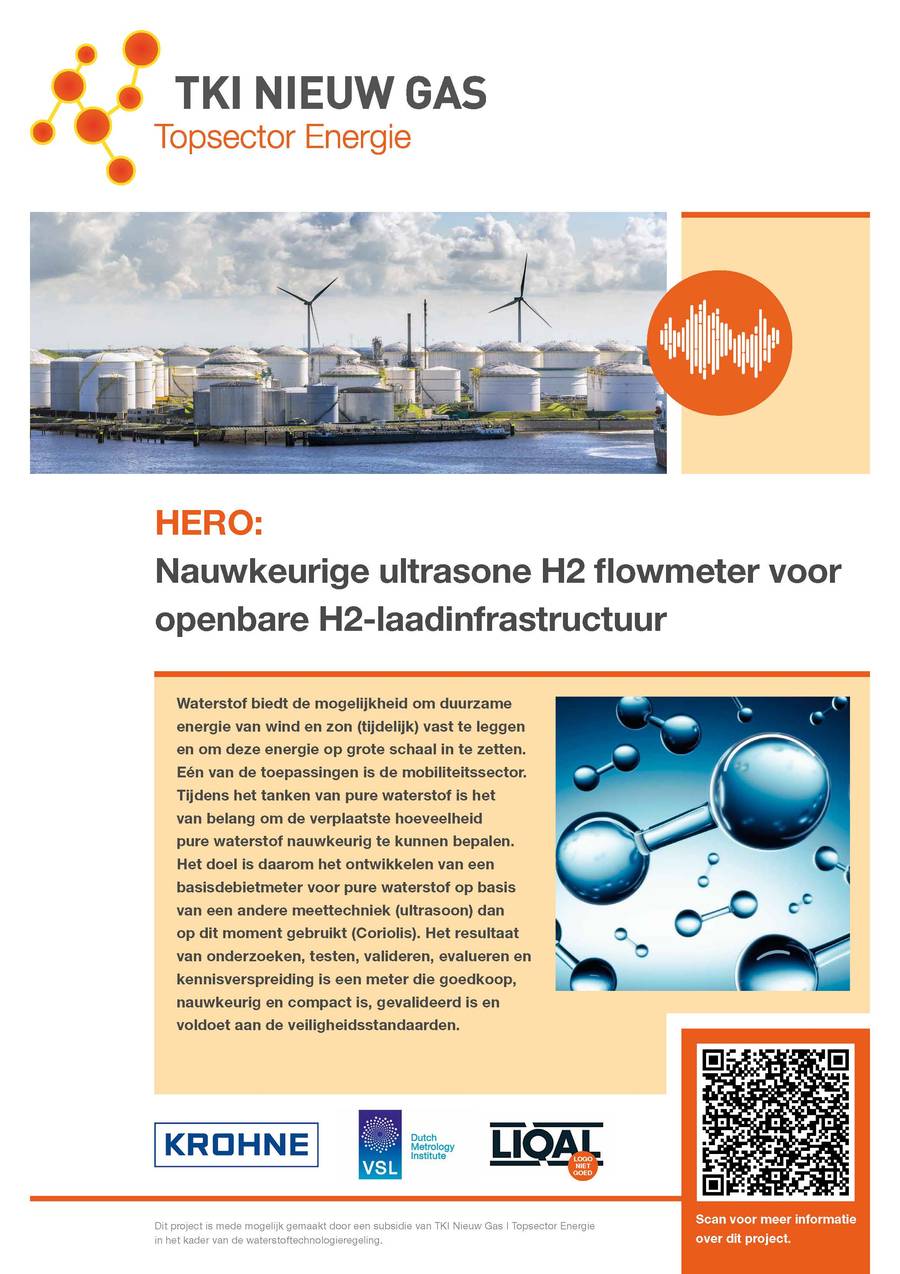
HERO [TKI2021-H2-13]
Introduction
Within the energy transition, hydrogen is a promising energy carrier and sustainable fuel. Hydrogen offers the possibility of capturing energy from wind and sun in molecular form (chemical energy) and of using this energy on a large scale for potentially a multitude of applications. One of these applications is the mobility sector, where hydrogen represents an important opportunity to make this sector more sustainable. Hydrogen is therefore on the rise within road transport. Passenger cars and trucks equipped with a fuel cell system fill up with hydrogen and only emit water as a residual product. Hydrogen can therefore make a significant contribution to reducing CO2 emissions through large-scale application in the mobility sector; road transport is responsible for almost twenty percent of these emissions.
In many countries there is therefore increasing support for the development of a hydrogen infrastructure in order to reduce greenhouse gas emissions. This infrastructure contains a network of hydrogen refueling stations that is necessary to enable the widespread acceptance of hydrogen fuel cell vehicles (always a refueling station nearby).
When refueling with pure hydrogen, it is important to be able to accurately determine the amount of pure hydrogen displaced (and therefore refueled). However, the hydrogen meters that are currently used for this are not accurate enough (this uncertainty can amount to as much as 10% deviation when a tank is partially filled). To comply with the applicable legislation for compressed gas such as hydrogen (OIML R139 is followed in the Netherlands), the flow meter may deviate by a maximum of 2% for uncertainty class 4. However, it is desirable to achieve uncertainty class 2, where the flow meter has a maximum of 1.5% may deviate. Stricter requirements (max. 1% deviation on the meter) apply to other compressed gases (such as CNG) than to hydrogen, as measuring hydrogen is currently more difficult. It is desirable for the protection of the consumer to harmonize this in the long term. In addition, the currently available Coriolis hydrogen meters are relatively expensive with the associated impact on the investment costs for a new filling station. They are also large, making the layout of filling stations complex or requiring more space. Due to the measuring principle used, refueling can also take longer than desired. For a further upscaling of the national H2 charging infrastructure, more accurate, more affordable and more compact meters are therefore needed. This project is the first step in the development of such a hydrogen flow meter for filling stations.
Objectives
The aim of this project is to develop a basic flow meter for pure hydrogen that is relatively cheap (10% of the price of current hydrogen flow meters), accurate (0.5% deviation over the entire desired pressure range), compact and validated, and meets the safety standards for hydrogen meters.
This flow meter will be based on ultrasonic technology.
GO / NO GO
The purpose of this section is to provide an analysis of the technical challenges and risks associated with the development of an ultra-sound flow meter for hydrogen refueling. Based on the findings in Work Package 1.
Technical Challenges:
During the course of Work Package 1, several technical challenges have been identified that make it difficult to develop an ultra-sound flow meter for hydrogen refueling. The key technical challenges are as follows:
Inner Diameter of the Tube: The project started with an assumption that an inner tube diameter of between 15mm and 20mm would be sufficient. However, it has been found that the inner diameter needs to be reduced to 3mm. This reduction poses a significant challenge as there is no technical solution to have an inner diameter of 3mm from the dispenser side.
High Speed of Sound: The high speed of sound in hydrogen (about 1320 m/s) requires a high transducer frequency (above 4 MHz) to achieve a narrow beam shape of the sound pulse, which is necessary to avoid reflections. However, with the high transducer frequency and the low pressure (at the beginning of refueling), the acoustic absorption in hydrogen causes problems.
Transducer Concepts: The project has evaluated two concepts of transducers, one based on piezoelectric transducers surrounded with epoxy and another system based on mechanical resonators. However, neither of these concepts will work with the high-pressure changes that occur during a fueling. The only idea for a solution we see is to have a more open design where the piezoelectric element is freely mounted. However, this design is not suitable as it will be too mechanically weak to withstand the vibrations and pressure pulses that will be in the dispenser.
Risks
There are significant risks associated with the development of an ultra-sound flow meter for hydrogen refueling. These risks include:
- Mechanical Weakness: The proposed solution of having a more open design with the piezoelectric element freely mounted is too mechanically weak to withstand the vibrations and pressure pulses that will be in the dispenser.
- Calibration: Calibration with hydrogen is both difficult and expensive. This will result in the flow sensor being significantly more expensive than an alternative meter like Coriolis sensor which is only need to be calibrated on water.
Alternative flow meter for fast fueling
Coriolis flow meters are a well-established technology that can accurately measure the mass flow rate of fluids. Coriolis flow meters are commonly used for a wide range of fluids, including hydrogen. They have been proven to be reliable, accurate, and stable over long periods. Additionally, they do not require any calibration with the fluid being measured, which makes them an easy-to-use solution for hydrogen refueling applications. Compared to ultrasonic flow meters, Coriolis flow meters have a smaller measurement range, but they are less affected by changes in fluid properties such as pressure, or density. Therefore, for hydrogen refueling applications Coriolis flow meters are a viable alternative to ultrasonic flow meters.
Decision (NO GO)
Based on the technical challenges and risks associated with the development of an ultra-sound flow meter for hydrogen refueling, we recommend stopping the project. The project's technical challenges, including the difficulties in achieving an inner diameter of 3mm and the high speed of sound in hydrogen, make it impractical to develop a working ultra-sound flow meter. Furthermore, the risks associated with the project, including the mechanical weakness of the proposed solution and the high cost of calibration, make the project unfeasible. Therefore, we recommend discontinuing the project and exploring the alternative solutions.
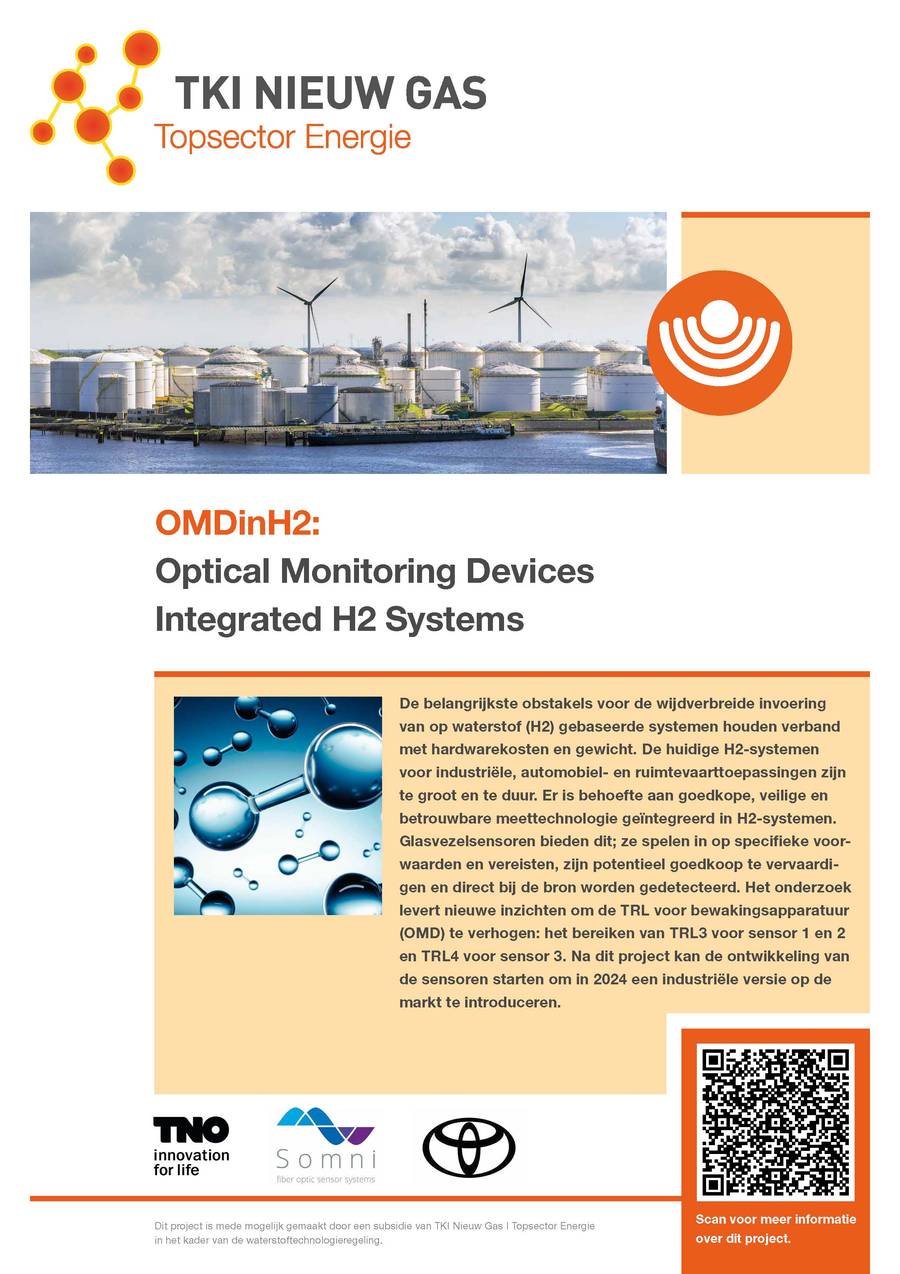
Optical Monitoring Devices Integrated H2 Systems – Fuel Cell and Storage Tank for H2FCV [TKI2021-H2-14]
Reason
The main obstacles to widespread adoption of hydrogen (H2)-based systems are related to hardware costs and weight. Because there is no information on actual operational lifetime behavior of essential components, current H2 systems for industrial, automotive and aerospace applications are oversized and thus heavy, large and costly. If we could measure their performance we could improve safety, reduce size and lower total cost of ownership (TCO) of H2 systems including cost of leasing and insurance.
It helps to establish value-based cost-price models. Society therefore urgently needs cheap, safe and reliable measurement technology integrated into H2 systems. Especially for two hardware components: the fuel cell and the H2 tank. Fiber optic sensors offer this; they can address specific conditions and requirements of both components, are potentially inexpensive to manufacture, can be placed in subsystems, and thus detect directly at the source. This enables lifetime and safety monitoring, lowers TCO,
and enables mass market adaptation. This project is focused on industrial research on three types of sensor technologies, bringing them to TRL3-4, and ready for experimental development.
Goal of the project
Objective is perform research and initial tests in controlled conditions of three optical
fiber sensor systems as optical monitoring devices (OMD) for H2 applications: 1) Integrated fiber Bragg grating (FBG) quasi-distributed (QD) sensor array systems for critical parameters, 2) Hollow Core Photonic
Bandgap (HC PBG) gas analyser for monitoring contaminants in H2 fuel, and 3) coating based H2 leakage sensor as a safety gauge. Crucial sensing parameters will be determined by considering sensing needs from
the end-user and available sensing solutions in the research field. The project will also address a major drawback of current local-level measurement that hinders widespread use, namely the invasive nature of
the measurement. Aim is to obtain the maximum amount of information, while minimizing disturbances to nominal system operation. This project contributes to both goals and two topics of the subsidy. It focuses
on new technologies that reduce cost and weight, and increase efficiency, safety and stability - lowering TCO of H2 systems. It introduces new (optical) measurement and analysis techniques for H2 systems which are cheap, scalable, and global replicable for every H2 system.
Short description of the activities
The project consists of five work packages, all strongly related to the
main deliverables, and various sub-packages assigned to one or more stakeholders, all classified as I.O.:
1. Define sensing requirement and operating conditions for three optical fiber sensor systems;
2. Literature and theoretical study, and design sensor systems for critical sensing parameters;
3. Laboratory experimental setup of optical sensor systems and validate functionality, Integration of sensor 1 (FBG QD) in fuel cell and H2 tank composite;
4. Testing sensors in applied H2 systems and collecting sensory data;
5. Analysis of sensory data to obtain insight for their functionality and obtain proof-of-principle OMDs in H2 systems.
Result
The research will gain new insights to raise the TRL for the OMD systems: reaching TRL-3 for sensor 1 and 2; and TRL4 for sensor 3. Furthermore, a number of lab-scale prototypes and proof of principles will be built to support the above research results. After this project, the actual development of the sensors can
start in order to have an industrial version ready to be marketed by 2024. The end result for H2 systems in general will be three measurement systems that will significantly improve safety and reduce costs and as
such will open up the mass market. With the new knowledge gained, after this project, the consortium can continue to develop dedicated fiber sensors for integration into the fuel cell and tank systems.
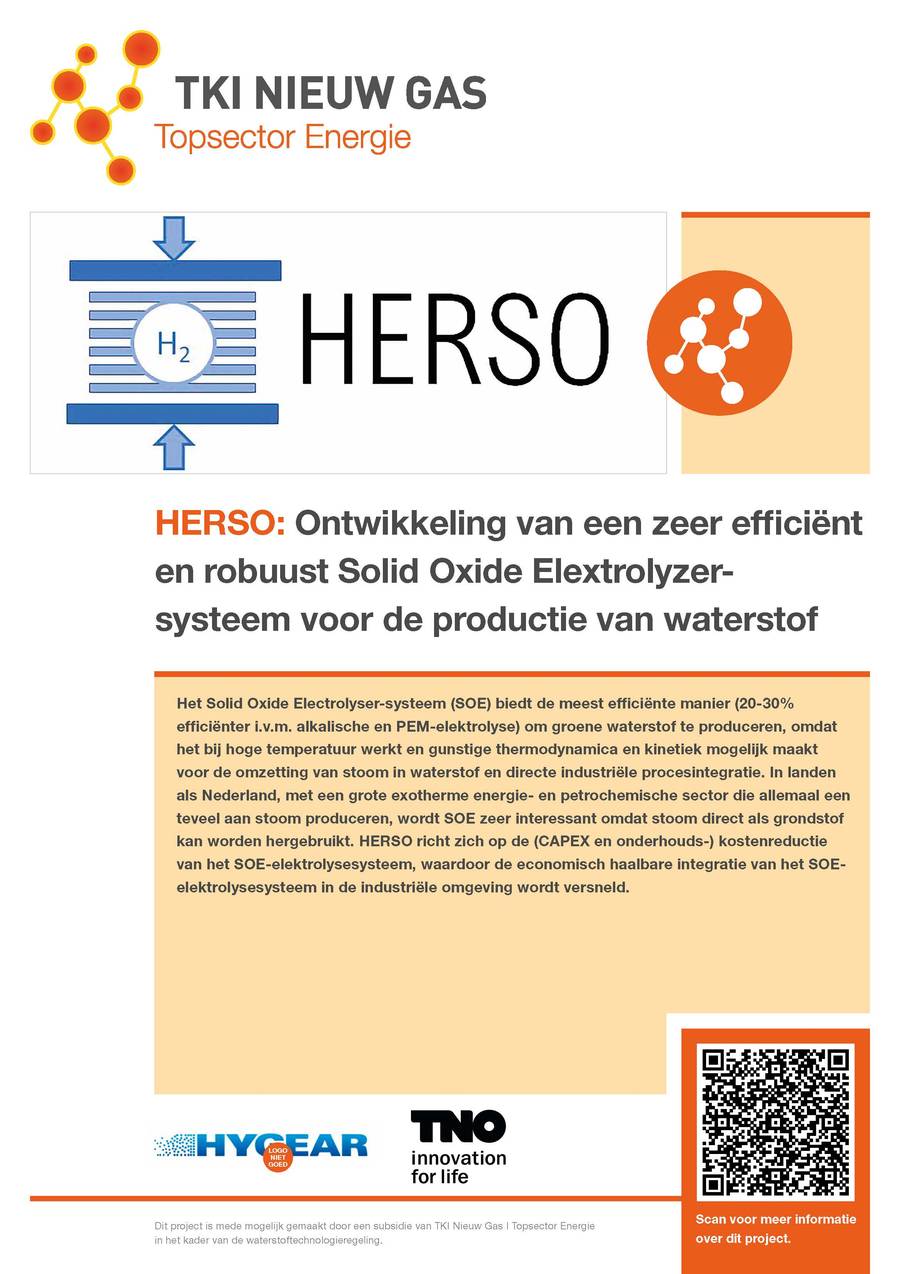
Development of a Highly Efficient and Robust Solid Oxide Electrolyzer system for hydrogen production [HERSO] [TKI2021-H2-21]
Motivation:
Large scale green hydrogen production through water electrolysis is one of the important solutions towards the Energy Transition and to meet the CO2 emission reduction goals. Solid Oxide Electrolysis (SOE) offers the most efficient way (20-30% more efficient compared to Alkaline and PEM electrolysis) to produce green hydrogen, due to its operation at high temperature allowing favorable thermodynamics and kinetics for conversion of steam into hydrogen and direct industrial process integration. Especially in countries like the Netherlands, with a large exothermic energy and petrochemical sector (Rotterdam, Geleen, Zeeland and Delfzijl), which all produce excess of steam, SOE becomes highly interesting, due to its capability of direct reuse of steam as feedstock. First field- ready systems, manufactured by Haldor Topsoe, Sunfire, Genvia and Solid Power, are already available on the sub-MW scale while 100MW scale systems are expected to be in operation in 20241. To enhance the competitiveness of SOE even more, we would like to contribute to the CAPEX reduction target (80-90%) which is prognosticated by Hydrogen Europe (EU Joint Undertaking European Industrial & Research parties dealing with electrolyzer systems) in 2030 and to improve system lifetime of SOE electrolyzer systems.
Project goal:
HERSO aims at the (CAPEX and maintenance) cost reduction of the SOE electrolyzer system, accelerating economic viable integration of the SOE electrolyzer system in the industrial environment.
Project activities:
The HERSO project goals will be achieved by focusing on increasing efficiency and
lifetime of the SOE stack technology and simplification of the SOE system by increasing stack and system operating pressure. The following activities contribute to this focus:
· System design study on the SOE electrolyzer system addressing an improved operational match between stack and balance-of-plant design resulting in lower CAPEX and OPEX (lower maintenance) for the overall SOE electrolyzer system.
· Development of robust performing solid oxide cells and a short 1-3 cell stack with improved current density, robustness and lifetime for pressurized H2-SOE operations (3-10 bar);
· Assessment of the robust SOE electrolyzer system and integration potential in the industrial environment.
Results:
The HERSO project will generate the following results:
· SOE system design with improved match of stack properties with the balance-of-plant
components resulting in simplified less expensive and robust performing (integrated) SOE electrolyzer systems;
· Solid oxide cells and short 1-3 cell stack with increased hydrogen productivity (> 7 ml/min H2/cm2 cell area), increased hydrogen pressure (3-10 bar) and increased stack lifetime (degradation rate < 10 mV/1000 hours);
· Roadmap of the HERSO technology towards implementation and demonstration in the
industrial environment; With these results the HERSO project contributes to the realization of economic and technical viable green hydrogen generation value chain within the next 5 years.
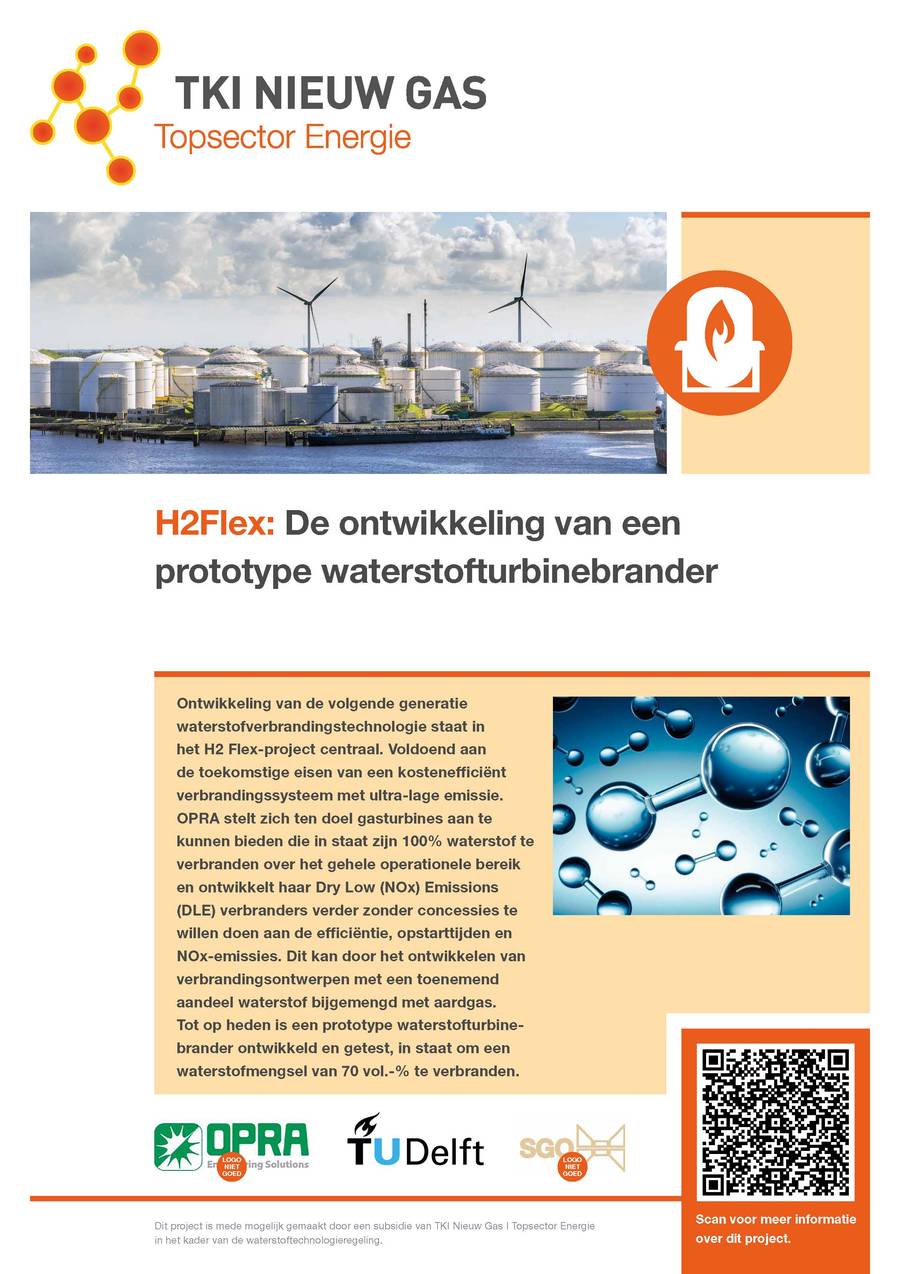
H2 Flex [TKI2021-H2-23]
Rationale/introduction
With the phasing out of natural gas, hydrogen appears to be a cost-effective solution for continuing to use the gas grid, and at the same time to realize clean electricity and heat in the industry. The combustion of hydrogen leads to solely water and energy as products and avoids any CO2 emissions. Besides that, turbines can easily be used in environments where there is a large supply of excess renewable electricity that can feed electrolyzers to produce hydrogen. In this way, stored hydrogen can be used in case of direct electricity or heat demand to relieve (for example) the regular grid. Consequently, OPRA notices a large increase in the requests regarding the application of hydrogen in gas turbines.
Purpose of the project
OPRA Engineering Solutions B.V. (hereafter: OPRA) and TU Delft will be working together on the development of the next-generation hydrogen combustion technology. This technology will meet the future requirements of a cost-effective, ultra-low emission combustion system for the OPRA gas turbine that can operate on 100% natural gas and 100% hydrogen, and any mix thereof. The challenge is to do this without compromising efficiency, startup times, and emissions of NOx. This will be achieved by developing combustor designs with an increasing proportion of hydrogen blended with Natural Gas. Moving towards hydrogen gas turbines allows for cleaner combustion processes without any byproducts other than water. The H2 Flex project contributes directly to technology development that is required for the successful implementation of hydrogen chains and that will lead to improved performance in the short term. Besides that, the technology widens the applications for hydrogen as fuel.
Brief description of activities
OPRA has set a target of being able to offer Gas Turbines capable of burning 100% hydrogen across the operational range and is further developing its Dry Low (NOx) Emissions (DLE) combustors to service the expected demand as a result of the unfolding hydrogen economy. The challenge is to do this without compromising efficiency (e.g. flashback combustion control and injection strategy), startup times, and emissions of NOX. This is being achieved by developing combustor designs with an increasing proportion of hydrogen blended with Natural Gas. H2 Flex contributes directly to technology development that is required for the successful implementation of hydrogen chains and that will lead to improved performance in the short term. Improved performance is defined as significantly lower investment and/or operational costs, higher efficiency, less maintenance, wider applications, greater measurement accuracy, less use of scarce materials, and reduced spatial impact compared to the state of the art.
Result
The overall result of H2 Flex is a developed and tested hydrogen turbine burner prototype, capable of burning a 70 vol.-% hydrogen mixture. This development specifically addresses the goal ‘Burner technology for hydrogen’ of the tender which includes topics such as modifications to turbine burners (taking into account possible effects on product quality) and burners for high-temperature heat avoiding emissions of other harmful components (such as NOx). During H2 Flex, the aim will be to achieve a 70 vol.-% hydrogen mix for the burners since CO2 reduction improvement develops non-linear after 50 vol.- %. The estimates are realistic, as OPRA has already been able to carry out tests with a 30 vol.-% hydrogen mix. It is expected that the biggest technical challenge will be to rise above 50 vol.-% hydrogen.
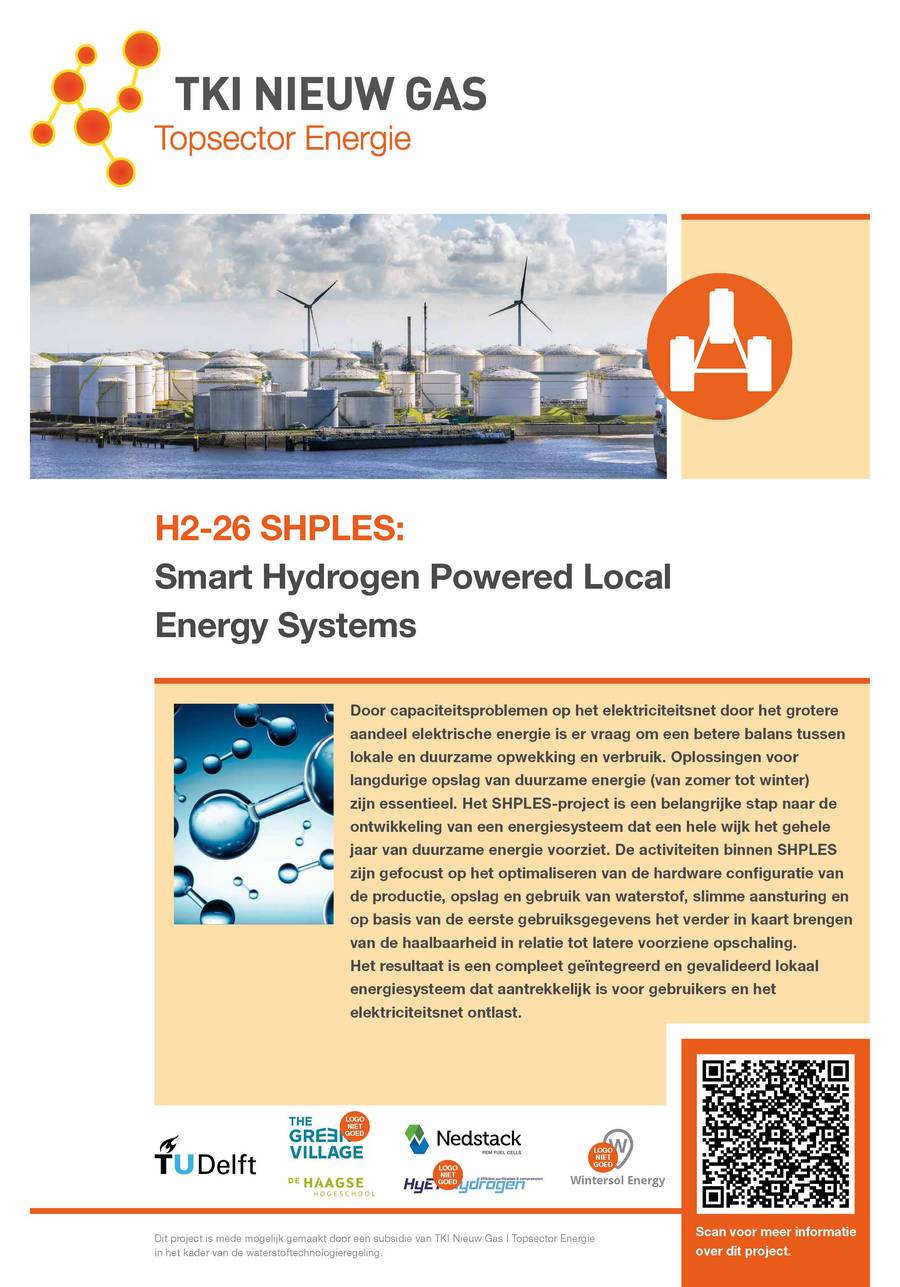
Smart Hydrogen Powered Local Energy System SHPLES [TKI2021-H2-26]
Aanleiding:
Door de energietransitie zal het aandeel van elektrische energie sterk stijgen. Echter reeds nu al wordt door Tennet en de Regionale Netbeheerders (RNB) capaciteitsproblemen op het elektriciteitsnet gemeld. De vraag dringt zich op of het mogelijk is een betere balans tussen lokale en duurzame opwekking en verbruik te realiseren waardoor er minder transport op het netwerk nodig is. Hiervoor zal op slimme wijze lokale vraag en aanbod van duurzame energie optimaal op elkaar afgestemd moeten worden. Oplossingen voor langdurige opslag van duurzame energie (van zomer tot winter) zijn hierin essentieel. Binnen het SHPLES-project gaan we een compleet geïntegreerd duurzaam residentieel energiesysteem (opwek-opslag-gebruik) ontwikkelen met behulp van PV en een combinatie van energie opslag in de vorm van elektriciteit in een batterij en waterstof. Het prototype systeem wordt zo ontworpen en gebouwd dat het in een gebouwde omgeving in een buurt of wijk kan worden gebruikt.
Doel van het project:
Het doel van het ‘SHPLES-project’ is om een lokaal en CO2 vrij energiesysteem gebaseerd op hernieuwbare energie bronnen te ontwikkelen dat autonoom en real-time haar performance optimaliseert en de gewenste control mogelijkheden biedt aan operators van het systeem. Dit kunnen energiebedrijven, netbeheerders, maar ook zogenaamde prosumers (energiecorporaties/gebruikers die zelf opwekken, bufferen) zijn. Het systeem wordt ontworpen voor en gedimensioneerd naar gebruik in de gebouwde omgeving. Het te ontwikkelen systeem gebruikt waterstof als tijdelijk energie-opslagmedium. Daarvoor is een slimme koppeling tussen verschillende technologieën (elektrolyzer, compressie, opslag en brandstofcel) nodig en een besturingssysteem die het energiesysteem optimaal en vraaggestuurd laat opereren. Dit nieuw te ontwikkelen geïntegreerde besturingssysteem maakt gebruik van slimme algoritmen en zou de ‘lingua franca’ kunnen worden voor het aansturen van dit soort decentrale energiesystemen die gebruik maken van waterstof.
Het project zal leiden tot nieuwe kennis op het gebied van het gebruik van waterstof in de gebouwde omgeving en inzicht geven hoe effectief waterstof is als medium om energienetten te balanceren op wijkniveau. Het consortium heeft voorafgaand aan dit project al het systeemontwerp gemaakt en de hardware aangeschaft. Met dit project wil het consortium een volgende grote stap te maken in de technologische ontwikkeling die nodig is voor het realiseren en verbeteren van de prestaties van dit soort energiesystemen. Het eindresultaat van het project is een complete geïntegreerde, robuuste en efficiënte oplossing die aantrekkelijk zou moeten zijn voor de beoogde gebruikers en die gevalideerd en geoptimaliseerd is in een living lab en klaar is voor opschaling in de openbare ruimte.
Korte omschrijving van de activiteiten:
Het SHPLES-project is een belangrijke stap naar de ontwikkeling van een energiesysteem dat een hele wijk het gehele jaar van duurzame energie kan voorzien. Het is dan ook de bedoeling dat na afloop van het project dit type systeem op meerdere locaties in Nederland kan worden ingezet om netproblematiek op te lossen.
De activiteiten die we binnen de looptijd van het SHPLES-project willen uitvoeren zijn gefocust op het optimaliseren van de gehele hardware configuratie van de productie, opslag en gebruik van waterstof, de slimme aansturing, en op basis van de eerste gebruiksgegevens het verder in kaart brengen van de haalbaarheid in relatie tot latere voorziene opschaling.
WP1: Systeem analyse en optimalisatie
WP2: Ontwikkelen slimme aansturing
WP3: Onderzoek naar kosten van concept bij opschaling en inzicht in vergunningsaspecten’
Resultaat:
Een compleet geïntegreerd en gevalideerde lokaal energiesysteem dat aantrekkelijk is voor gebruikers en het elektriciteitsnet ontlast.
De ontwikkeling van dit product zal leiden tot:
1 Versnelling van de uitrol van decentrale lokale energiesystemen;
2 Vergroting van de kennis over de combinatie van batterij en waterstofopslag als flexibele energievoorziening voor residentiële toepassing
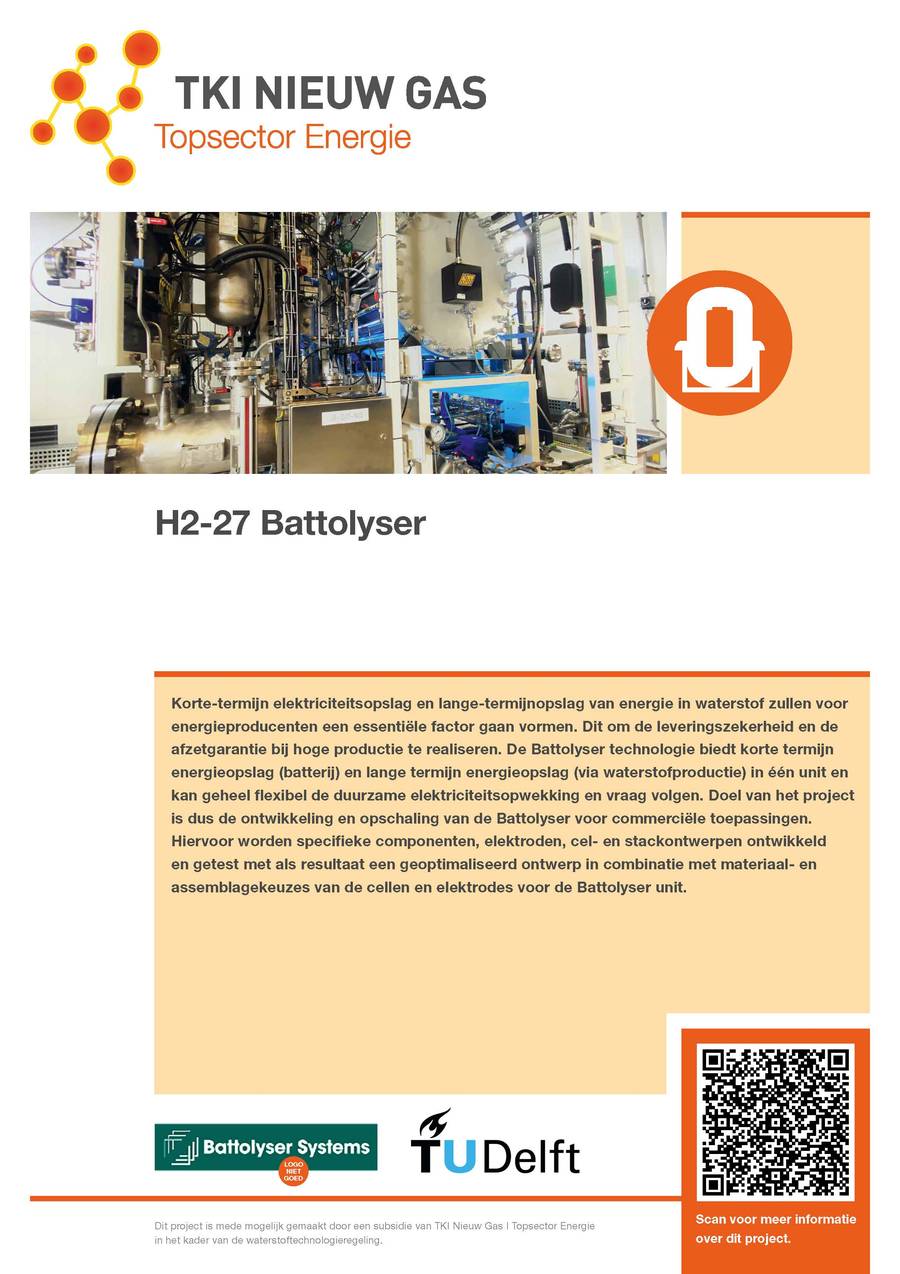
Battolyser [TKI2021-H2-27]
Aanleiding
Om de doelstellingen voor de implementatie van hernieuwbare elektriciteitsopwekking en CO2- reducties in 2030 en 2050 te kunnen halen, zal er op een efficiënte manier een keten gerealiseerd moeten worden, die opgewekte elektriciteit optimaal benut en voor toeleveringszekerheid kan zorgen. Hiervoor zal de grote variatie van de opwekking van zonne- en windenergie op zowel de korte- als lange tijdschalen aangepast moeten worden aan de maatschappelijke vraag. Korte-termijn elektriciteitsopslag en lange-termijnopslag van energie in waterstof zullen beide voor energieproducenten een essentiële factor gaan vormen. Dit om de leveringszekerheid enerzijds en de
afzetgarantie anderzijds bij hoge productie te realiseren. De Battolyser technologie biedt korte termijn energieopslag (batterij) en lange termijn energieopslag (via waterstofproductie) in één unit, en kan geheel flexibel de duurzame elektriciteitsopwekking en vraag volgen. Hiermee wordt toename en inpassing van duurzaam opgewekte energie in het systeem mogelijk met minder druk op het elektriciteitsnet, en kan waterstof efficiënter en goedkoper worden geproduceerd voor toepassing in o.a. industrie en mobiliteit.
Doel van het project
Doel van dit project is de ontwikkeling en opschaling van de Battolyser voor commerciële toepassingen. Hiervoor moeten specifieke componenten, elektroden, cel- en stack ontwerpen ontwikkeld en getest worden. Battolyser Systems is na de realisatie van een TRL-7 pilot op 15kWh/15kW schaal klaar om op te schalen naar MWh/MW capaciteit. Hiermee wordt de technologie gereed gemaakt voor commerciële toepassingen op industriële schaal. De elektroden, celontwerpen en materiaalgebruik worden geoptimaliseerd om een hogere efficiëntie, gereduceerde kosten, en daarmee lagere waterstof productiekosten voor de gebruiker te bereiken. Tegelijkertijd moeten de componenten geschikt worden gemaakt voor nauwkeurige grootschalige productie. De onderdelen worden getest in een testopstelling op The Green Village, het buiten laboratorium op de TU Delft Campus, in een omgeving met gesimuleerde grid interfaces. Deze zal tevens onderdeel worden van het “24/7 Sustainable Energy Project” aldaar, dat als doel heeft een geïntegreerde systeem omgeving voor groene stroom opwek (PV), opslag en conversie naar waterstof, en aangesloten lokale gebruikers en netwerken te realiseren in de gebouwde omgeving.
Korte omschrijving van de activiteiten
1. Optimaliseren elektrodes en celontwerpen
• Ontwerp verbeterde cellen
• Materiaal selecties
• Ontwerp verbeterde elektrodes
2. Fabricage geoptimaliseerde cellen in testoplage
• Productie nieuwe celcomponenten
• Assemblage nieuwe cellen
4. Testen van geoptimaliseerde celontwerpen in gesimuleerde omgeving The Green Village
• Testen
• Feedback naar ontwerpteam (WP1)
• Kennisdeling
Resultaat
Het resultaat van dit project is een geoptimaliseerd ontwerp in combinatie met materiaal en assemblage keuzes van de cellen en elektrodes voor de Battolyser unit, waarmee de cellen gereed worden gemaakt voor massaproductie en commerciële toepassing op industriële schaal (TRL-8). Voor het testen van de geoptimaliseerde celontwerp zal Battolyser Systems een onderzoeksfaciliteit
ontwikkelen op op The Green Village in Delft. Hiermee verwacht het project ook een bijdrage te kunnen leveren aan de volgende zaken in de technologie ontwikkeling van de waterstofketen in Nederland:
- Simulaties van operationele situaties van de Battolyser en ervaring opdoen met operationele veiligheid
- Nieuwe toepassingen en business modellen te testen
- Ervaring opdoen met vergunningen in en rondom de gebouwde omgeving
- Een mogelijkheid voor afstudeerwerk voor studenten elektrotechniek, chemie,
werktuigbouwkunde, duurzame energie of vergelijkbaar
- Systeemintegratie van de Battolyser technologie met electriciteitsnetwerk en PV Solar op The Green Village (mogelijke vervolgfase)
- Systeemintegratie met het waterstofnetwerk van The Green Village (mogelijke vervolgfase)

